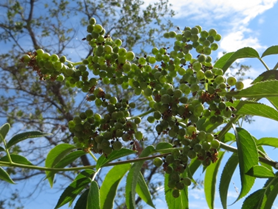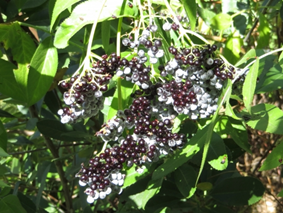GOING WILD WITH NATIVES: Elderberries And Currants, Ribes Species, Plants With Benefits!
- k-england
- May 31, 2021
- 4 min read
Updated: Mar 2, 2022
By Susan Lewitt.

Here are some sweet native plants to consider that give you edible treats: Blue Elderberry, Sambucus nigra ssp. caerulea, White Flowering Currant, Ribes indecorum, and two Chaparral Currants, Ribes malvaceum, and Ribes malvaceum var. viridifolium.

Blue Elderberry is a winter deciduous plant and can be grown as a tree or shrub. It ranges from Oregon to Baja California in Mexico, and east to Western Texas, in places that are slightly moist like stream banks, and slope bottoms.
Blue Elderberry berries and flowers are edible, but pick berries when they are ripe and then cook all parts. They are poisonous otherwise. There’s less toxin in ripe berries and cooking destroys the toxin, or you can just leave them for the birds. Cooked berries have been used to make sauces, jams, and wines. A German soup using Elderberry is called Fliederbeersuppe. The flower heads are tasty as infusions, teas, jellies, wine and in fritter recipes. Large quantities act as a laxative because of the hydrocyanic acid.
This plant may grow quickly up to 30’ tall and 30’ wide as a tree or bush, but can be pruned to maintain a lower height. It can take full sun to full shade and tolerates many different soil types except salty. It does best in medium to fast draining soil with low moisture as in riparian areas. Once established, it will only need once-monthly summer watering.
Blue Elderberry attracts about 23 pollinator species including white-lined sphinx, Polyphemus (a common silk moth) and Drasteria ochracea (a brown and orange moth). It provides nectar, fruit, and nesting space for wildlife, including native bees, chipmunks, and birds. It also attracts insects that control pests. It’s found with vegetation of chaparral, sage scrub, grasslands, and wetland-riparian. Good companions include Toyon, Coast Live Oak, other oak species, and White Flowering Currant.
Above from left to right, Blue Elderberry buds, Blue Elderberries not yet ripe and ready to pick Blue Elderberries.

Want more sweet garden treats? White Flowering Currant and two Chaparral Currants are good species for San Diego. Imagine the lovely fragrance that fills your landscape as these currants start to bloom with white, pink, and purple flowers around October through May. All three grow moderately to fast, to at least 5’ tall with the two Chaparral Currants spreading to 5’ wide and the White Flowering Currant forming a columnar shape 2’ wide. All three are deciduous for parts of the year.
Rich loamy, slow to medium draining soil is ideal for the White Flowering Currant, while the Chaparral Currants need medium and coarse, fast draining soil. Like the Elderberry, White Flowering Currant only needs a once-a-month summer watering after it’s established, but the two Chaparral Currants may need water twice a month in summer once established. All tolerate full sun to part shade.
These plants are important to native bees, hummingbirds, butterflies, other pollinators, and small mammals. Some beautiful visitors that you might see by these plants include the Hoary Comma, Milbert’s Tortoiseshell, and up to 70 others. Some companion plants for the White Flowering Currant include Spiny Redberry, Mission Manzanita, Laurel Sumac, Coast Live Oak, and Sugar Bush. It might even hide underneath a Western Sycamore.
You can use the edible fruits of the Chaparral Currants for jams and jellies. The leaves make a tasty addition to herbal teas. White Flowering Currant has been used medicinally. (If you are not familiar with a plant, check with knowledgeable landscaper or botanist before attempting to eat it. Many plants that are safe also have toxic varieties.)

These natives make good garden choices, for bird, butterfly, and bee gardens. They provide flowers, fragrance, and food, and are deer resistant. With careful planning, these and other native plants can make your garden attractive all year round and eco-friendly. References follow for recipes and further information.
I haven’t mentioned, in this article, exotic species that you want to avoid. I’ve changed my focus to the wonderful qualities of our native plants and how they support biodiversity, especially the ones that work well in home gardens.
When you decide to plant something, look it up on Calflora.org to make sure it isn’t a non-native invasive plant. Invasive plants are a problem if you live close to natural areas, and most people in San Diego are surrounded by natural areas. Invasive plants easily spread to areas by wind and wildlife, by runners and seeds, competing with the native plants, and attempting to take over. Also, please keep in mind that exotic plants, whether invasive or not, don’t support biodiversity. They haven’t evolved alongside our native plants or pollinators.
References:
California Native Plant Society Calscape, Restore Nature One Garden At a Time, https://www.calscape.org/
Evergreen Landscaping, “Chaparral Currant”, https://evergreenlandscapingca.com/chaparral-currant/
Gardens All, “Sambucus Canadensis and Sambucus Nigra, the Edible Elderberries” https://www.gardensall.com/sambucus-canadensis/
“Great Design Plant: Sambucus Nigra Caerulea for the Birds” https://www.houzz.com/magazine/great-design-plant-sambucus-nigra-caerulea-for-the-birds-stsetivw-vs~46990153
Herbal Focus: Blue Elderberry (Sambucus nigra ssp. caerulea) https://www.nicoleapelian.com/blog/herbal-focus-blue-elderberry-sambucus-nigra-ssp-caerulea/
My German Recipes, Elderberry Soup: Fliederbeersuppe https://mygerman.recipes/elderberry-soup-fliederbeersuppe/





